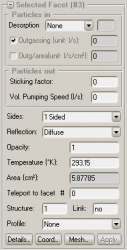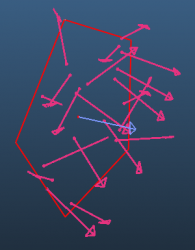This panel allows you to define physics and simulation parameters of all the selected facets.
Desorption type
If enabled, you can select the angular distribution of the desorbed particles. Possibilities are:
Uniform - particles will fly out to every direction with equal probability for every (spatial) angle.
Cosine - corresponds to a Lambertian radiator where the probability of the angle of radiation is proportional to the cosine of that angle. This means in practice that particles are more prone to leave a facet perpendicular to its plane.
Cosine^N - The same as above, but the probability is proportional to a chosen power of the cosine of the angle. In practice, the higher the exponent is, the more perpendicular the gas will flow to the facet.
Outgassing and Outgassing per Area

Here you can define the quantity of the gas coming in at the selected facets. The units are "unit * liter / sec", so if you prefer to use mbars as the pressure units, then you can enter outgassing values in mbar*l/s, just read pressure values in mbar, correspondingly.
Defining for a single facet:
If only one facet is selected, then the outgasssing and outgassing/area values are calculated as you type, taking into account the area of the selected facet. The checkboxes don't have any meaning.
Defining for multiple facets:
The conversion between the outgassing and outgassing/area uses the sum area of the selected facets. The checkboxes define which of the two values will be kept fixed, when outgassing is applied to multiple facets.
Examples:
- You want to set the outgassing of 10 facets to 0.5mbar*l/s each: type 0.5 to the outgassing field, and apply the parameters keeping the "Outgassing" checkbox ticked
- You want to set the outgassing of 100 different-sized copper facets to 1E-9 mbar*l/s/cm2 uniformly: type 1E-9 to the "Outgassing/area" field, and apply parameters with the checkbox ticked next to it.
- You have an outgassing structure, for example a hemisphere consisting of a lot of facets. You want a total outgassing of 10mbar*l/s distributed between the facets, proportional to the element areas: select all facets of the hemisphere, enter 10 to the "outgassing" field, that will calculate the necessary "outgassing/area" value, then apply parameters with the outgassing/area checkbox ticked.
Sticking factor and volumetric pumping speed

Sticking factor: The probability (0..1) that a particle that hits this facet will be absorbed.
Volumetric pumping speed: It is converted to sticking factor before being applied. Note that if multiple facets are selected, the sum are is taken into account at the conversion. The proper way of defining volumetric pumping speeds for multiple pumps is to calculate the corresponding sticking factor on one facet, then applying the sticking factor on all selected facets. This function might change with the upgrades to be more like the desorption definition (two checkboxes). The formula used for the conversion is:
[volumetric pumping speed] = [facet area] * [average molecule speed] * [sticking factor] / 4
where the average molecule speed depends on the gas mass and temperature, so if you change it, don't forget to update the pumping speeds.
Sides
One-sided facet: particles only collide from the side where its normal vector is pointing. It is transparent from the other side. If the facet has outgassing, particles only desorb towards the normal vector side.
Two-sided facet: particles can collide with it from both sides. If it has outgassing, it desorbs on both sides. Also, when calculating pressure, its area is taken into account two times (for both sides), since it can receive particles from both ends.
Reflection
Defines whether particles should be relaunched mirrored to the incident direction, or if they should be launched randomly at a cosine-wighed (Labertian) directional distribution.
Opacity
The probability (0..1) that a particle going through the facet hits it. Useful for defining transparent facets for measuring the pressure in arbitrary planes.
Temperature
Facet temperature. Currently used for sticking factor / volumetric pumping speed conversion (molecule speeds are temperature-dependent)
Area or Sum Area
Displays the selected facet's area in cm^2. This is the sum area if multiple facets are selected.
Teleport to facet #
Teleports incoming particles to the given facet. 0 to disable. See setting up periodic systems for usage.
Structure
Defines which superstructure the facet belongs to. See superstructures for more info.
Link
Particles hitting a link facet will look for collisions with the structure whose number is given here. See [Superstructures] for more info.
Profile
Enables counting of pressure distribution along the U and V vectors of the facet(s), or the angle distribution or particles hitting / traversing the facet.


